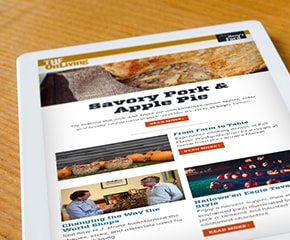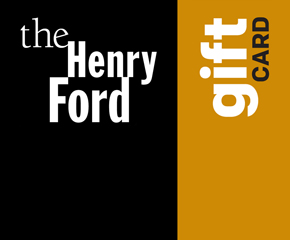
Preston Tucker and the Tucker 48
18 artifacts in this set
This expert set is brought to you by:
The staff at The Henry Ford
Henry Ford, Harvey Firestone, Preston Tucker, Henry Ford II, Benson Ford, and Edsel Ford at Indianapolis Motor Speedway, 1932
Photographic print
Preston Tucker loved cars as a boy. As an adult, he partnered with the brilliant race car designer Harry Miller to produce a series of front-wheel-drive cars for the Indianapolis 500. Tucker and Miller convinced Ford Motor Company to sponsor the effort. Ten cars were built but, without proper time for testing, the cars failed to finish the 1935 race.
1935 Miller-Ford Race Car
Racing car
Harry Miller, one of America's most important racing designers, built this car for Ford Motor Company's effort at the 1935 Indianapolis 500. It has all of Miller's hallmarks -- innovation, craftsmanship, and an almost sculptural presence. All that it lacks is a victory. Miller built ten similar cars, but a hurried production schedule led to mechanical problems and none finished the race.
1948 Tucker Sales Brochure, "The Story of the Tucker '48"
Brochure
Preston Tucker dreamed of building and marketing a car of his own. The postwar seller's market, when American demand for new automobiles soared, gave him a perfect opportunity to act on that vision. Tucker promised a groundbreaking car with a rear engine, all-wheel independent suspension, and disc brakes. He boldly advertised it as "the car you’ve been waiting for."
Preston Tucker Presenting the 1948 Tucker Sedan
Photographic print
Preston Tucker unveiled his Tucker 48 prototype in a glitzy ceremony at the Tucker Corporation's Chicago plant on June 19, 1947. Some 5,000 people came to see the car Mr. Tucker had been promoting in newspapers and magazines for months. The crowd loved it. In the following weeks, many investors and dealers signed on with Tucker based on that enthusiasm.
Three-Quarter View of a 1948 Tucker Sedan
Photographic print
Stylist Alex Tremulis refined Preston Tucker's initial concepts into a workable -- though still exceptionally striking -- vehicle design. The Tucker 48 was distinguished by its three headlights, rear fender vents (for the rear-mounted engine), doors that cut into the roof (to provide more headroom for passengers getting in and out of the vehicle), and dramatic fastback rear end.
Stock Certificate, "One Hundred Shares of Tucker Corporation Class A Common Shares," 1948
Stock certificate
To build his car -- and his company -- Tucker needed money. He made an initial offering of five million shares of stock in his Tucker Corporation of America. As many as 44,000 people bought shares by September 1947, raising $15 million for the company. Tucker also sold franchises to dealers eager to sell his new car.
Car Radio for 1948 Tucker Automobile
Car radio
Tucker sold more than stock. He sold accessories -- suitcases, seat covers and radios -- for yet-to-be-built Tucker cars. Customers received tangible pieces of their cars, and also a preferred spot on the company's waiting list. The sooner you bought your radio, the sooner you got your car. The unconventional program earned $1 million in profit for the Tucker Corporation.
View of a 1948 Tucker Torpedo, with Press Release on Preston Tucker's Award from the Museum of Science and Industry
Photographic print
After unveiling his prototype Tucker 48 in June 1947, Preston Tucker took the car on a nationwide publicity tour. At New York's Museum of Science and Industry, thousands of visitors paid 48 cents each for a chance to view the car. Thousands more saw the prototype in Los Angeles, Chicago, and other American cities.
1948 Tucker Advertisement, "Here's Why the Tucker '48 is Years Ahead!"
Photographic print
Preston Tucker promoted his Tucker 48 sedan heavily to interest investors as well as would-be customers. His claims sometimes got ahead of reality. While some of the features in this ad -- rear engine, four-wheel independent suspension -- made it into Tucker's production cars, others -- fuel injection, torque-converter transmission, disc brakes -- were dropped due to engineering or manufacturing difficulties.
Section of The Sunday Bulletin, Philadelphia, from April 18, 1947, Showing 1948 Tucker Automobile Advertisement
Newspaper
Preston Tucker previewed his all-new Tucker 48 sedan with a massive marketing campaign. Articles and advertisements appeared in newspapers across the country, like this one from Philadelphia's Sunday Bulletin. The ad emphasized the Tucker Corporation's seasoned management team, which included veterans from General Motors, Chrysler, Ford, and Borg-Warner -- in addition to Mr. Tucker himself.
Tucker Corporation Employee Badge, circa 1948
Badge
The Tucker Corporation based itself in Chicago in a war-surplus factory that had produced engines for B-29 bomber airplanes. At its peak, Tucker employed some 1,600 people. The company anticipated having 35,000 employees once it reached full production.
1948 Tucker 48 Sedan
Automobile
Swooping fenders and six exhaust pipes make the Tucker look like a rocket ship. But Preston Tucker's car mixes fantasy with practicality. The center light turns with the front wheels to cast light around corners. Taillights are visible from the side for safety. Doors curve into the roof for easier entry and exit, while grilles on the rear fenders feed cooling air to the rear-mounted engine.
Front View of a 1948 Tucker Sedan
Photographic print
The Tucker 48's center headlight was its defining feature. The light was connected to the car's steering mechanism. When the Tucker traveled in a straight line, the light was off. But when the steering wheel was turned ten degrees in either direction, the light switched on and turned with it, lighting the driver's way around corners.
Engine of 1948 Tucker Sedan in Henry Ford Museum, December 1964
Photographic print
Preston Tucker's prototype car carried a 589-cubic-inch, 6-cylinder engine, but development problems forced him to find a different powerplant for the production vehicles. He selected a 334-cubic-inch 6 originally designed for helicopters. To ensure a steady supply, Tucker bought the company that made it -- Air Cooled Motors of Syracuse, New York.
Driver Controls, 1948 Tucker Sedan in Henry Ford Museum, December 1964
Photographic print
When the Tucker Corporation's steering wheel contractor could not make the deadline for the first series of production cars, Alex Tremulis reached out to his contacts at Ford Motor Company. Ford supplied Tucker with units from its Lincoln Zephyr. That cooperative gesture seemingly undercuts the argument that the Big Three -- or Ford, at least -- were out to destroy Tucker.
"Mechanix Illustrated Drives and Tests the New Tucker," 1948
Reprint
Automotive journalist Tom McCahill wrote glowingly of the Tucker 48 in the August 1948 issue of Mechanix Illustrated. McCahill praised the car's smooth ride, quick acceleration and roomy interior. It was a welcome bit of good news for the Tucker Corporation, which was facing increasing financial and legal troubles.
Tucker Corporation Business Card, circa 1948
Business card
Tucker's unconventional fundraising methods -- the accessories program in particular -- drew the attention of the U.S. Securities and Exchange Commission. The SEC investigated Tucker and charged him with fraud. Although he was found not guilty, bad press from the investigation and trial ultimately ended Tucker’s company and his dream in 1950.
Movie Poster, "Tucker: The Man and His Dream," 1988
Poster
Director Francis Ford Coppola brought Preston Tucker's story to the big screen in the 1988 film Tucker: The Man and His Dream. Jeff Bridges played the supersalesman out to revolutionize the postwar auto industry with his futuristic, rear-engine Tucker 48 sedan. Though some scenes and characters were fictionalized, the movie accurately captured the excitement generated by Tucker's car.


